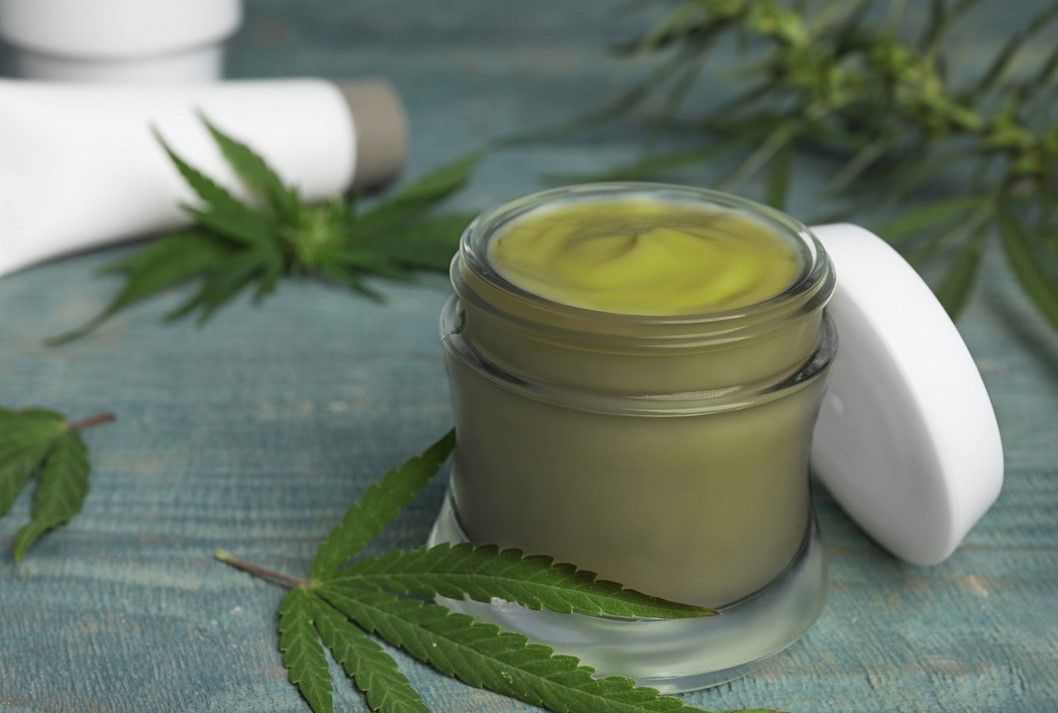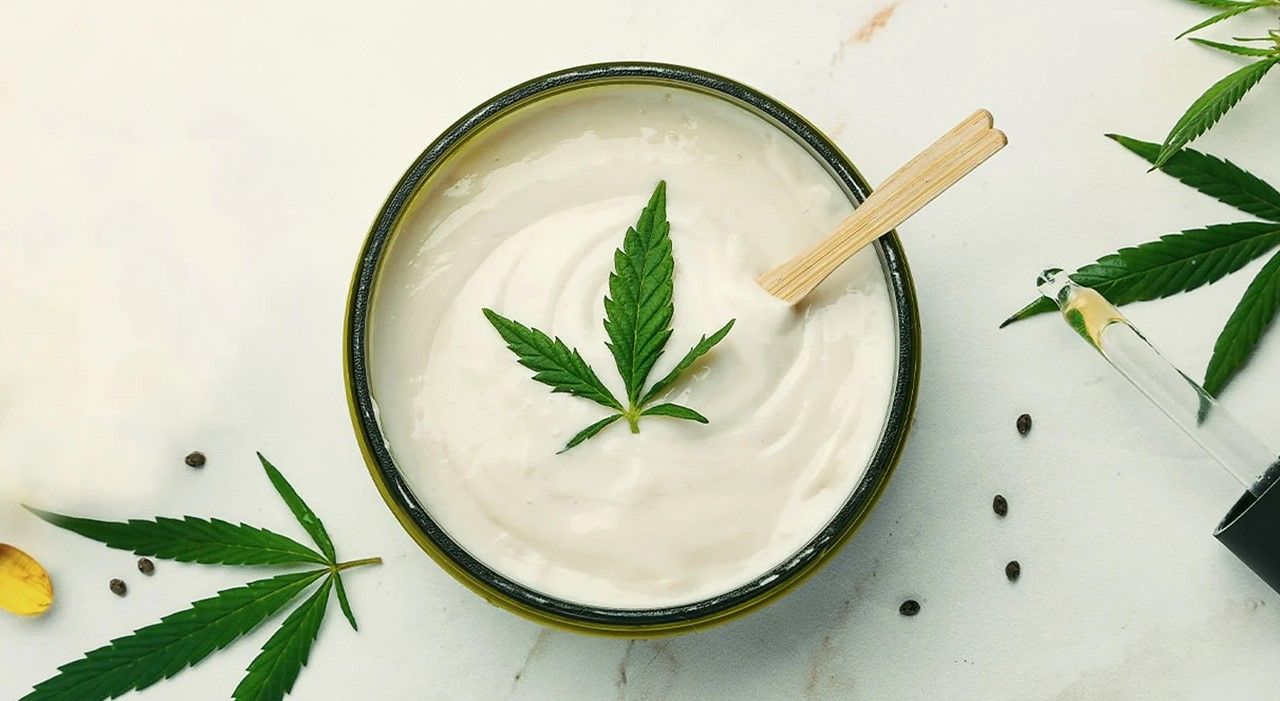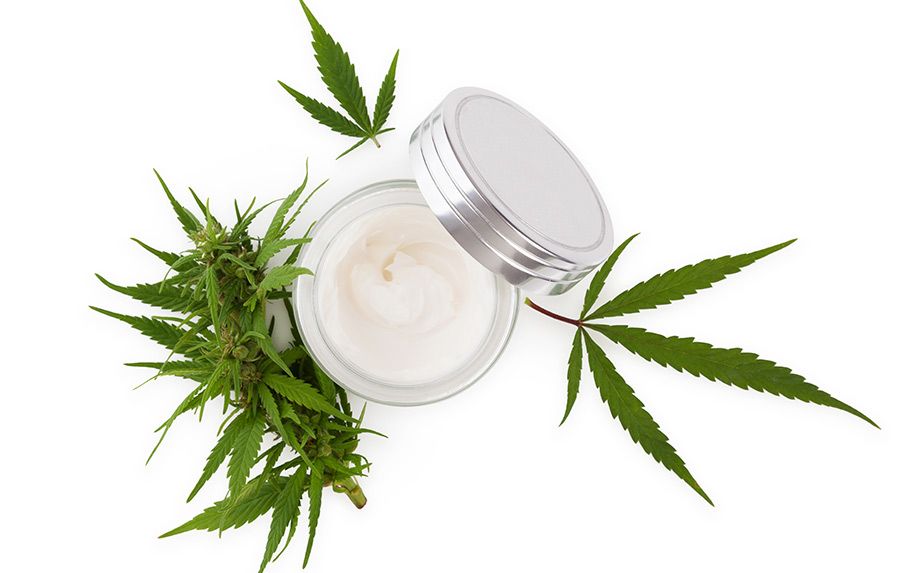Revolutionary is a pretty big word but can definitely be used in the context of cannabis-infused lotions and balms. They provide medicinal benefits without the psychoactive effect of THC.
While puffing away on a joint or hitting a bong are still well-loved methods of consuming cannabis, other forms like edibles, vaporizing, and topicals are becoming increasingly popular.
Now that we know a bit more about cannabis topicals, let’s dive deeper into how they work and how you can make your own at home.
What Are Cannabis Topicals and How Do They Work?
There are many types of cannabis topicals, including creams, balms, lotions, oils and lubricants. These products work by using cannabinoids and terpenes from the cannabis plant to activate receptors in the epidermis and dermis.
What Are the Benefits of Cannabis Topicals?
The advantages that cannabis topicals have are dissimilar from other methods of using the plant. For example, those with THC can provide the benefits of the cannabinoid without producing a head high—something some people don’t want or enjoy. Unlike smoking or vaporizing, which sends cannabinoids and terpenes into your bloodstream and to receptors throughout your body, topicals only affect a small area.
Check out other benefits of cannabis topicals:
- They’re easy to use. Although dabbing or smoking cannabis can be tricky- especially for beginners, using a topical is as easy as smearing cream or lotion on your skin.
- They’re simple to dose. It’s easy to consume too much cannabis via smoking, vaping, or eating weed. With topicals, however, dosing is straightforward, and taking a larger dose won’t result in any negative consequences.
- They offer a slow, steady, and controlled release. Smoked or vaped cannabis can take effect almost immediately, while edibles can up to an hour. Users often find both to be overwhelming. Topicals offer a happy medium between the two: they work quickly and also provide a steady release that allow users to re-apply when needed.
- They omit the lungs. Although some people who use cannabis argue that it is not harmful, studies have found that the smoke from marijuana has many of the same dangerous chemicals as tobacco smoke.
- They avoid first-pass metabolism. If you consume cannabis in the form of a brownie, capsule or oil tincture, it typically loses potency by the time it enters your bloodstream. However, topicals bypass this issue because they don’t go through the digestive system.
- They avoid drug fluctuation levels. When you smoke or vaporize cannabis, the number of cannabinoids and terpenes delivered to your system varies a lot depending on how you do it. Topicals provide a more dependable level of cannabinoids and terpenes, which is good for anyone using cannabis medicinally or who needs constant relief.

CBD Topicals
Did you know that cannabis topicals are a thing? If not, then let me tell you about them! They offer an entirely different way to use cannabis than other methods. And even though you might have not applied these products to your skin yet, people have used them for thousands of years. In total, there are hundreds of molecules found in cannabis that we’re interested in. But one cannabinoid has been rising in popularity lately for topical use: CBD. This is because it’s legal in many places and there are lots of ongoing studies about its pharmacological action. Today, There are many companies that make CBD topicals, including:
- Topical CBD oil
- CBD cream for skin
- Lotions
- Balms
- Salves
- Patches
The endocannabinoid system (ECS) is the universal regulator of human processes such as growth and cell differentiation, and it has a presence in the skin. Although more research needs to be done in this area, CBD shows promise in being able to support ECS function and, by extension, help maintain healthy skin. CBD has been shown to interface with the ECS, and scientists are currently testing the cannabinoid against inflammation, pain, and ageing. CBD can interact with many ingested medications, so people taking these drugs may prefer to apply it topically.
How to Apply Cannabis Topicals
- Wash your skin with mild soap and warm water, then dry it completely.
- Before using a new lotion, always test it on a small area first. This way you can avoid any skin irritation. If you’re wanting to ease some muscle soreness, then gently massage the cannabis lotion into the affected area. You can apply more if needed.
- Wash your hands to remove any excess lotion.
- Quick Guide to Making a Cannabis-Infused Balm
So, you now understand what cannabis topicals are. Great! Now it’s time to get our hands dirty and create something ourselves. Even though we don’t have the facilities or production processes of a big corporation at home, we can still make our own natural cannabis balm. From a technical standpoint, making lotions and creams out of cannabis is very similar to creating cannabutter. If you know how to make cannabutter, then you pretty much know how to make these kinds of products too!
INGREDIENTS AND EQUIPMENT:
- 250–500ml of coconut oil
- 15–30g of dried cannabis flower
- Cooking pot
- Cheesecloth (or any kind of fine mesh material)
- Ingredients that improve skin health, like beeswax, shea butter or almond oil (customize according to your skin’s needs).
- Storage containers
METHOD
- Preheat your oven to 110°C and grind your flower for 45 minutes.
- Pour your coconut oil into the cooking pot and set it to low heat.
- Gently simmer your decarboxylated ground flower in oil for at least 3–4 hours.
- Add any additional ingredients you wish to use to enrich your topical with, then remove the mixture from the heat and let it cool a bit.
- Using a cheesecloth, strain the mixture into your desired storage containers. You can use your hands to squeeze the flowers in order to avoid wasting any product.
Feel free to get creative and experiment with different ingredients to make your own tailor-made cannabis cream or lotion. All the normal suspects like shea butter, almond milk, etc., can be great add-ins for your homemade cannabis concoction. Once you figure out what works best for you, you’ll experience cannabis in a whole new way!
What Can Cannabis Topicals and Lotions Do for You?
Is weed good for your skin? Although more research is needed to confirm this, many people continue to use topical cannabis as part of their skincare routine. Beyond CBD, the plant produces a host of other cannabinoids that can interact with the ECS in the skin, including THC, CBG, and cannabinoid acids. Considering that THC underpins the psychoactive effects of cannabis, it might seem strange that some people chose include this compound in their skincare routine.
THC, similarly to CBD, influences the ECS. However, THC does so more directly; the molecule has a strong liking for CB1 and CB2 receptors which are two of the primary sites that make up this system. Therefore, THC can activate areas that are linked with necessary physiological processes in skin healing including proliferation, differentiation, inflammation control ,and cell death
Cannabis also produces other phytochemicals that are currently used in skincare products, such as:
- Terpenes: Cannabis contains over 150 aromatic compounds, some of which are being studied for their potential benefits in healing wounds, reducing inflammation, and treating fungal infections.
- Flavonoids: Cannabis produces a plethora of these antioxidant compounds; some are also found in other plants, but many are unique to cannabis. Researchers think that these moleculeshave the potential for anti-inflammatory, antiproliferative, anti-ageing, and photoprotective effects.
Cannabinoids, found in cannabis, have generated much excitement lately within the realm of topical application. Of all cannabinoids, CBD has gained the most traction for use in skincare products. This is partly because THC is very difficult to study due its illegal status in many parts of the world. The following will provide an overview of what scientific research says about CBD and acne, eczema, wounds, and other skin conditions.
CBD: Wounds and Pain
So, where does CBD fit into this wound care paradigm? Can you use CBD oil on an open wound? Unfortunately, using any cosmetic product on an open wound increases the risk of infection. Even though there is very little evidence so far that suggests CBD might help heal burns or wounds, some studies are beginning to test its effects. These tests focus on things like wound healing, blistering, and pain. Interestingly enough, CBD binds to a receptor called TRPV1—which happens to be a site involved in the perception of pain. Furthermore, other studies are also investigating the possibility that CBD has antimicrobial properties.
CBD and Acne
When the small glands in your skin produce an excess of sebum (an oily substance that protects and lubricates the skin), it results in acne. The overproduction of sebum goes on to block hair follicles, which then causes pimples. These sites can also attract bacteria, leading to inflammation and infections that cause more severe acne. So, does marijuana use have any effect on acne? If you experience the condition, should you try using cannabis lotion? Unfortunately, research remains limited. However, researchers are exploring if CBD might be able to help reduce inflammation in human sebocytes (the cells that create sebum).
CBD and Eczema
Many things factor into eczema, like an overactive immune system, genetics, and everyday environment triggers such as those found in detergents and dry weather. And while many treatments for eczema are available commercially today, not all of them work for everyone who suffers from the condition. This is where CBD oil comes in: recent studies have shown that it could possibly help reduce inflammation (a big player when it comes to eczema) by modulating proinflammatory cytokines and affecting T-cell proliferation levels. Not only does research show that CBD improves the levels of naturally occurring cannabinoids, but it is also effective in treating dryness and itchiness. When using CBD for this reason, start with a small amount to get an idea of how your body will react before applying more liberally.
CBD and Sunburn
Excessive exposure to ultraviolet (UV) light from the sun can cause skin burns. In the short term, this causes redness, peeling, and pain. Over time, such exposure can increase the risk of skin cancer. Many people are curious about whether CBD lotion could help prevent or relieve sunburn symptoms. Currently, researchers from the Medical University of Bialystok in Poland are assessing whether cannabinoids like CBD could offer any protection against changes in skin cells that occur following UV exposure. Several companies have launched CBD creams for sunburn, which are applied in the same manner as conventional sun creams. These anecdotal reports suggest that these CBD creams may be effective treatments for sunburn.
CBD and Psoriasis
Psoriasis manifests when the body replaces skin cells more rapidly than necessary. The process usually works like this: new skin cells grow at the deepest layer of skin and, over time, move to the surface where they replace older cells. In psoriasis cases, however, something disrupts this natural progression by causing immature skin cells to pile up on top of each other instead of shedding normally–this leads to dry, flaky patches and itchiness. Scientists are trying to determine if CBD can help reduce the inflammation and skin cell growth associated with psoriasis. However, some evidence suggests that CBD might actually cause an increase in certain types of skin cells. When using CBD cream, people with psoriasis should apply it generously.

CBD and Tattoos
Tattoos provide people with a unique way to express themselves—permanently. However, it’s no secret that getting a design inked onto the skin comes with a fair amount of pain. Some people choose to use CBD at different stages of the process in an attempt to curb nerves and dampen the pain. Certain users opt for inhaled or edible CBD products before an appointment, whereas others apply CBD topicals after the risk of infection has passed to soothe the area. Topical anaesthetics and soaps containing CBD, pain-blocking agents, and antiseptics are being developed by some companies for use on new tattoos. Although there is no scientific evidence yet, many people say that these products help to reduce tattoo pain.
CBD Transdermal Patches
Cannabinoid patches are often times a better choice than weed lotions because of the unique transdermal delivery system. While topical CBDlotions, creams, and balms only produce local effects on the skin, transdermal CBD patches deliver cannabinoids through the skinand into the bloodstream where it is more easily distributed throughoutthe body. Transdermal CBD patches work best when placed on areas with thinner skin such as the inner arm, lower back, or shoulders.
Transdermal patches provide CBD to the bloodstream, which then offers more widespread effects. They not only impact the skin but also go on to interface within the endocannabinoid system in various parts of human anatomy, like central nervous system, digestive system, cardiovascular system and elsewhere. For this reason, CBD transdermal patches are a good choice for users that want to “feel” CBD delivered directly their skin. However, they may not be as attractive an option for those who want externalminster cannabinoids or avoid internalising Cannabinoids for other reasons (such as drug interactions).
Cannabis Lotions: A Fun and Easy DIY Project
Now that you understand how to make your own topical cannabis lotion, let’s explore the science surrounding weed and skincare. Generally speaking, marijuana-based skincare products are uncomplicated to make and use, plus they can upgrade any ordinary skin care routine. However, if you still feel like something is missing after trying different cannabis lotions at home, consider using a cannabinoid patch which will give you systematic effects throughout your body.

